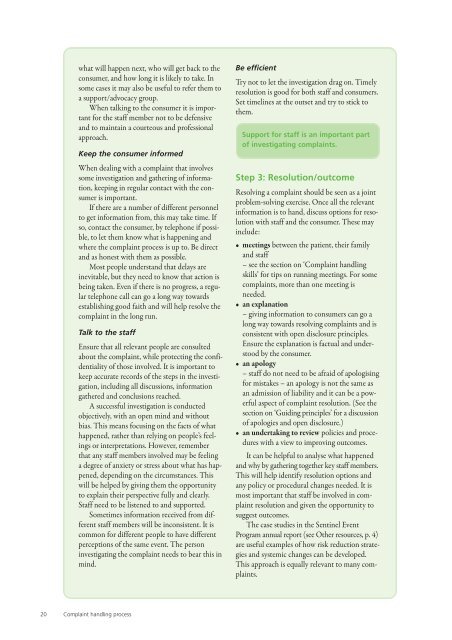Guide to Complaint Handling in Health Care Services
Guide to Complaint Handling in Health Care Services
Guide to Complaint Handling in Health Care Services
Create successful ePaper yourself
Turn your PDF publications into a flip-book with our unique Google optimized e-Paper software.
what will happen next, who will get back <strong>to</strong> the<br />
consumer, and how long it is likely <strong>to</strong> take. In<br />
some cases it may also be useful <strong>to</strong> refer them <strong>to</strong><br />
a support/advocacy group.<br />
When talk<strong>in</strong>g <strong>to</strong> the consumer it is important<br />
for the staff member not <strong>to</strong> be defensive<br />
and <strong>to</strong> ma<strong>in</strong>ta<strong>in</strong> a courteous and professional<br />
approach.<br />
Keep the consumer <strong>in</strong>formed<br />
When deal<strong>in</strong>g with a compla<strong>in</strong>t that <strong>in</strong>volves<br />
some <strong>in</strong>vestigation and gather<strong>in</strong>g of <strong>in</strong>formation,<br />
keep<strong>in</strong>g <strong>in</strong> regular contact with the consumer<br />
is important.<br />
If there are a number of different personnel<br />
<strong>to</strong> get <strong>in</strong>formation from, this may take time. If<br />
so, contact the consumer, by telephone if possible,<br />
<strong>to</strong> let them know what is happen<strong>in</strong>g and<br />
where the compla<strong>in</strong>t process is up <strong>to</strong>. Be direct<br />
and as honest with them as possible.<br />
Most people understand that delays are<br />
<strong>in</strong>evitable, but they need <strong>to</strong> know that action is<br />
be<strong>in</strong>g taken. Even if there is no progress, a regular<br />
telephone call can go a long way <strong>to</strong>wards<br />
establish<strong>in</strong>g good faith and will help resolve the<br />
compla<strong>in</strong>t <strong>in</strong> the long run.<br />
Talk <strong>to</strong> the staff<br />
Ensure that all relevant people are consulted<br />
about the compla<strong>in</strong>t, while protect<strong>in</strong>g the confidentiality<br />
of those <strong>in</strong>volved. It is important <strong>to</strong><br />
keep accurate records of the steps <strong>in</strong> the <strong>in</strong>vestigation,<br />
<strong>in</strong>clud<strong>in</strong>g all discussions, <strong>in</strong>formation<br />
gathered and conclusions reached.<br />
A successful <strong>in</strong>vestigation is conducted<br />
objectively, with an open m<strong>in</strong>d and without<br />
bias. This means focus<strong>in</strong>g on the facts of what<br />
happened, rather than rely<strong>in</strong>g on people’s feel<strong>in</strong>gs<br />
or <strong>in</strong>terpretations. However, remember<br />
that any staff members <strong>in</strong>volved may be feel<strong>in</strong>g<br />
a degree of anxiety or stress about what has happened,<br />
depend<strong>in</strong>g on the circumstances. This<br />
will be helped by giv<strong>in</strong>g them the opportunity<br />
<strong>to</strong> expla<strong>in</strong> their perspective fully and clearly.<br />
Staff need <strong>to</strong> be listened <strong>to</strong> and supported.<br />
Sometimes <strong>in</strong>formation received from different<br />
staff members will be <strong>in</strong>consistent. It is<br />
common for different people <strong>to</strong> have different<br />
perceptions of the same event. The person<br />
<strong>in</strong>vestigat<strong>in</strong>g the compla<strong>in</strong>t needs <strong>to</strong> bear this <strong>in</strong><br />
m<strong>in</strong>d.<br />
Be efficient<br />
Try not <strong>to</strong> let the <strong>in</strong>vestigation drag on. Timely<br />
resolution is good for both staff and consumers.<br />
Set timel<strong>in</strong>es at the outset and try <strong>to</strong> stick <strong>to</strong><br />
them.<br />
Support for staff is an important part<br />
of <strong>in</strong>vestigat<strong>in</strong>g compla<strong>in</strong>ts.<br />
Step 3: Resolution/outcome<br />
Resolv<strong>in</strong>g a compla<strong>in</strong>t should be seen as a jo<strong>in</strong>t<br />
problem-solv<strong>in</strong>g exercise. Once all the relevant<br />
<strong>in</strong>formation is <strong>to</strong> hand, discuss options for resolution<br />
with staff and the consumer. These may<br />
<strong>in</strong>clude:<br />
• meet<strong>in</strong>gs between the patient, their family<br />
and staff<br />
– see the section on ‘<strong>Compla<strong>in</strong>t</strong> handl<strong>in</strong>g<br />
skills’ for tips on runn<strong>in</strong>g meet<strong>in</strong>gs. For some<br />
compla<strong>in</strong>ts, more than one meet<strong>in</strong>g is<br />
needed.<br />
• an explanation<br />
– giv<strong>in</strong>g <strong>in</strong>formation <strong>to</strong> consumers can go a<br />
long way <strong>to</strong>wards resolv<strong>in</strong>g compla<strong>in</strong>ts and is<br />
consistent with open disclosure pr<strong>in</strong>ciples.<br />
Ensure the explanation is factual and unders<strong>to</strong>od<br />
by the consumer.<br />
• an apology<br />
– staff do not need <strong>to</strong> be afraid of apologis<strong>in</strong>g<br />
for mistakes – an apology is not the same as<br />
an admission of liability and it can be a powerful<br />
aspect of compla<strong>in</strong>t resolution. (See the<br />
section on ‘Guid<strong>in</strong>g pr<strong>in</strong>ciples’ for a discussion<br />
of apologies and open disclosure.)<br />
• an undertak<strong>in</strong>g <strong>to</strong> review policies and procedures<br />
with a view <strong>to</strong> improv<strong>in</strong>g outcomes.<br />
It can be helpful <strong>to</strong> analyse what happened<br />
and why by gather<strong>in</strong>g <strong>to</strong>gether key staff members.<br />
This will help identify resolution options and<br />
any policy or procedural changes needed. It is<br />
most important that staff be <strong>in</strong>volved <strong>in</strong> compla<strong>in</strong>t<br />
resolution and given the opportunity <strong>to</strong><br />
suggest outcomes.<br />
The case studies <strong>in</strong> the Sent<strong>in</strong>el Event<br />
Program annual report (see Other resources, p. 4)<br />
are useful examples of how risk reduction strategies<br />
and systemic changes can be developed.<br />
This approach is equally relevant <strong>to</strong> many compla<strong>in</strong>ts.<br />
20 <strong>Compla<strong>in</strong>t</strong> handl<strong>in</strong>g process

















